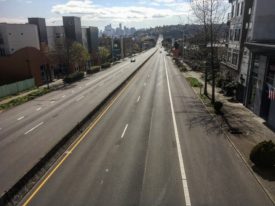The income gap widens:
In the United States, the richest 10 percent earn an average of US$93,000 – the highest level in the OECD. The poorest 10 percent earn an average of US$5,800 – about 20 percent lower than the OECD average.
Social mobility is lowest in countries with high inequality such as the United States, United Kingdom, and Italy, the report said.
 No surprises in the trend, really. It’s been going on for a long time—as has the decoupling of GDP growth and middle class income. (See the chart to the right, borrowed from Kevin Drum’s blog at Mother Jones.)
No surprises in the trend, really. It’s been going on for a long time—as has the decoupling of GDP growth and middle class income. (See the chart to the right, borrowed from Kevin Drum’s blog at Mother Jones.)
Still, I’m grateful that the AP article I link to above mentions the connection between income inequality and social immobility. It’s a story that needs to be told more often.
Opponents of policies designed to ease economic inequality often argue that they’re unnecessary, since people simply aren’t stuck where they’re born. If you want to earn more money, the argument goes, all you need to do is work hard. Maybe you won’t make it into the lucky 10%, but at least your kids might. Inequality, the argument goes, is actually necessary to upward mobility, since it gives people the belief that their hard work can really pay off.
But as it turns out, that’s simply backwards: places where incomes tend to be more equal also tend to be the places where people are more likely to move up the economic ladder. So in practice, income inequality turns out to be an obstacle to (or at least negatively correlated with) pulling yourself up by your bootstraps—quite the opposite of the standard argument.








Paul Birkeland
Good post, Clark. But I think we need an “elevator pitch” on the issue. I would suggest that in discussing this, we don’t argue that “places where incomes tend to be more equal also tend to be the places where people are more likely to move up the economic ladder,” but rather that a staircase with many stairs is easier to climb than one with only a few stairs. Similarly, a smooth income distribution with many smaller steps makes upward mobility more possible for all.In any event, we’re in trouble.
Jeffery J. Smith
If it’s earned, it’s not yours, so forget about taxing it. But the higher you go, the less income is earned. Still, rather than tax it out of envy, you could preclude the puddling of income in the first place. Try taxing the spending on nature, on land and natural resources and EM spectrum and charge full value for emission permits, patents/copyrights, corporate charters, etc. You’d have trillions that you’d have to share, a la Alaska’s oil dividend. You really do have to learn to feel enough self-esteem to feel entitled to a fair share of nature’s bounty. And get over that tired old Protestant Work Ethic, fast. Replace it with a Polynesian Play Ethic. Good for you, good for the environment, and shrinks the income gap.